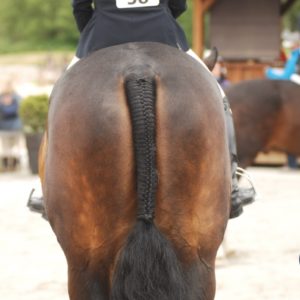It seems that horse trainers are always trying to label a horse’s “type.” Is he a leader or follower? Social or a loner? All seriousness or a total goofball?
The truth is, we horse owners like to categorize our horses with “types” for the same reason we like to identify people by their astrological signs: It gives us some way to explain behavior and personality…and it gives us some idea of what to expect! For those interested in horse types that can have a health component as well as explaining aspects of equine personality, then the system offered by Traditional Chinese Medicine is worth exploring. The veterinarian for the German national equestrian teams, Dr. Ina Gösmeier, explains the basics in her new book The 5 Horse Types.
***
According to Traditional Chinese Medicine (TCM), disease always has both a mental and physical component. This applies not only to the entire organism, but also to individual organs of the body. As part of this holistic approach with horses, TCM assigns both a psychological and physical aspect to every organ of the equine body.
For example, the liver (gan) is responsible for the balanced flow of qi (life energy) through the body, allowing the horse to move with elasticity and allowing the rider to apply light aids. If the horse develops a liver-qi stagnation, he’ll show signs of annoyance and discomfort, which, in horses, can lead to resistance, rearing, bucking, and biting. The kidneys (shen) are responsible for growth and reproduction. When they get out of balance, this can lead to a lack of self-confidence. Horses can then become chronically fearful and seem to constantly be spooking. This is why TCM places a lot of importance on tracking behavioral changes, which are often the first sign of a disruption in the body. They hint at disease before physical changes take place. For example, a horse who has always whinnied a greeting to his rider suddenly begins to turn away as the rider approaches. This shows he’s not feeling well! Therefore, it’s important to recognize subtle imbalances and correct them. In Western medicine, we’re aware that anxiety or being mentally overwhelmed are sources of illness such as burn-out, but we often don’t acknowledge these emotions as they relate to chronic diseases in our horses.

THE FIVE ELEMENTS
The Chinese worldview recognizes that constant change is nature’s primary characteristic. All creatures are constantly exposed to various conditions in their natural environment, and these conditions are always changing. All creatures can be influenced by these conditions and must try to adapt to them. This could include anything from seasonal weather changes to the type and quality of available nutrition to emotional stress.
In order to be able to describe these conditions in regards to their effects on health, TCM employs the study of the five elemental phases.
From the TCM perspective, there are also five organ pairings:
- Liver/Gallbladder
- Heart/Small Intestine
- Spleen/Stomach
- Lungs/Large Intestine
- Kidneys/Bladder
These organ pairings are organized in a specific sequence in a circle. They are each associated with one of the five elements and have considerable influence on one another.
The theory behind the five elements was established in 2000 BCE.
Each elemental phase and organ pairing corresponds with specific elements: for example, liver/gallbladder correlates with the element wood, while kidney/bladder correlates with water. In addition, each element is associated with specific character traits, which both describe the constitutional type and can be considered “balanced” or “out of balance.”

The first three types are easy to recognize, even for the layperson. It’s a bit more difficult to distinguish between the Lung-Fei and Heart-Xin Types. A veterinarian trained in TCM can help resolve any uncertainty by providing a diagnosis based on the pulse.
THE FIVE ELEMENTS
Wood 木 Mu-Wood Liver/Gallbladder
Fire 火 Huo-Fire Heart/Small Intestine
Earth 土 Tu-Earth Spleen/Stomach
Metal 金 Jin-Metal Lungs/Small Intestine
Water 水 Shui-Water Kidneys/Bladder
Based on these five elements, horses can be classified into five constitutional types.
Liver = 肝, Type = 型, Horse = 马; Thereby, we get:
Liver-Gan type 肝型马
Kidney-Shen Type 肾型马
Spleen-Pi Type 脾型马
Heart-Xin Type 心型马
Lung-Fei Type 肺型马
The Chinese description of each type will help any horse owner and rider better assess her horse, as well as develop him purposefully and perhaps avoid performance problems. It must always be emphasized that assigning a horse a type is never a negative! Instead, both strengths and weaknesses of each constitutional type are illuminated by TCM. When a horse is encouraged based on his positive characteristics, he can be developed extremely well. His rideability will improve, and he’ll willingly respond to his rider’s requests. We say that horse represents his type “in balance.”
If a horse is physically or mentally overburdened, the weaknesses of his type will become obvious. For example, the horse will respond unwillingly, fearfully, or with resistance, and eventually will present with illness. The horse still represents his type, but now he is “out of balance.”
Advantages of determining your horse’s type based on TCM:
- Recognizing your horse’s strengths and weaknesses
- Maintaining health
- Encouraging optimal development
- Improving rideability
- Solving behavior problems
- Improving the bond between rider and horse

This excerpt from The 5 Horse Types by Dr. Med. Vet Ina Gösmeier is reprinted with permission from Trafalgar Square Books (www.horseandriderbooks.com).




 December 11, 2020
December 11, 2020 






















